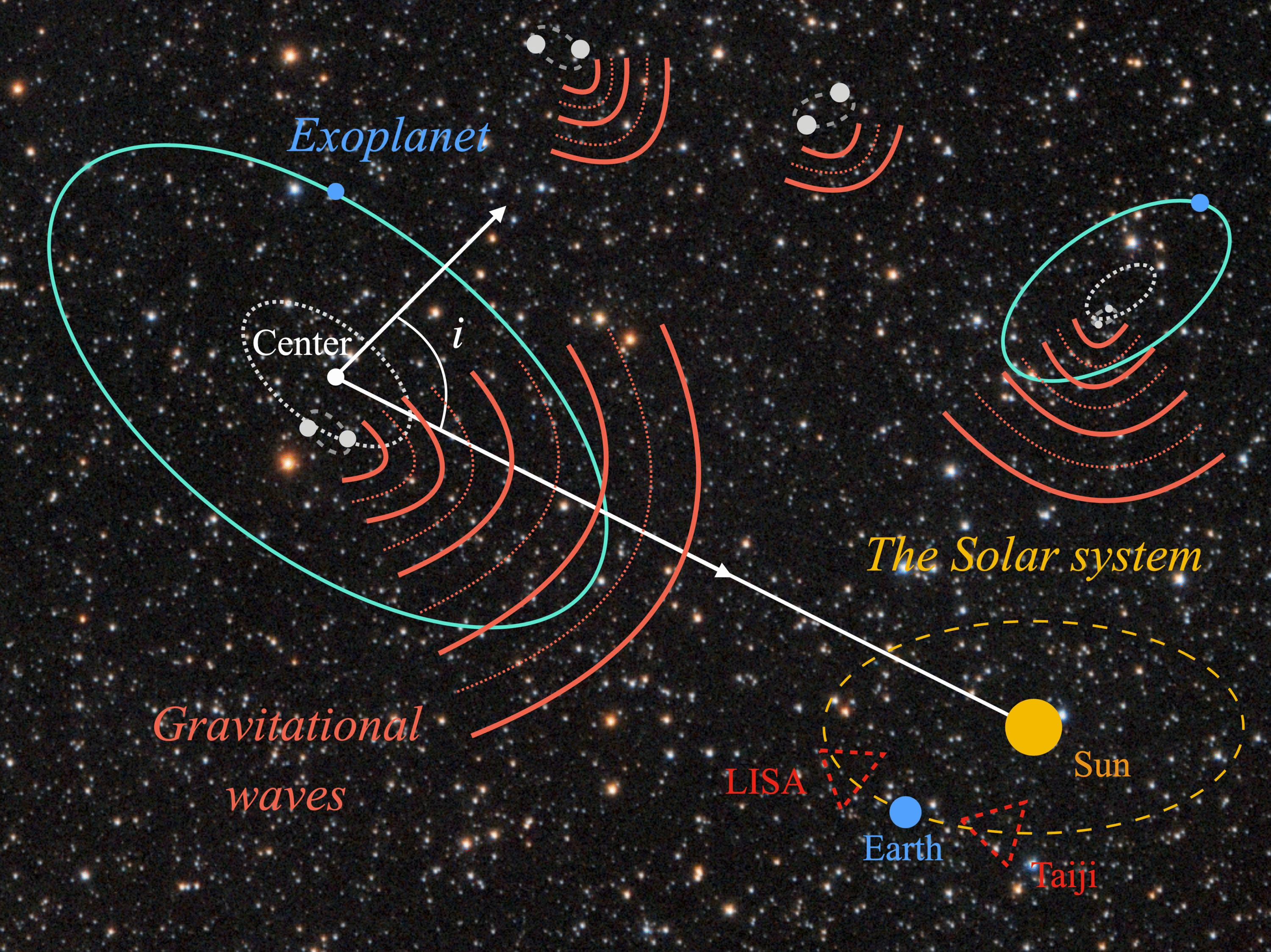Imagine that you could go back in time and ask Albert Einstein if people could directly detect gravitational waves, the extraordinarily faint ‘ripples’ in space-time, it must be hard for him to admit that people could make it come true about 100 years after his prediction. However, if you ask Mr. Yacheng Kang and Ms. Chang Liu right now, an undergraduate and a PhD student respectively in Prof. Lijing Shao’s group, the prospects for detecting exoplanets with gravitational-wave observations, they will have a slightly more positive attitude toward it and show more details about that.
Futuristic though this sounds, it is by no means a whimsical idea. As predicted in general relativity, gravitational waves could be generated from two orbiting bodies and propagate outward at the speed of light. Therefore, for a binary system which is massive enough to emit detectable gravitational waves toward us, the perturbation induced by an outer circumbinary exoplanet, if such a population indeed exists, can be extracted from its imprint on the gravitational-wave signal (see the Figure for illustration).

(© Yacheng Kang, with background image by Zhuokai Liu)
Given that more than 97% of stars will end their lives as the so-called ‘white dwarfs’, some dense forms of stellar core remnants, and about 50% of Solar-type stars are not single, there should be a considerable population of double white dwarfs in our Galaxy. Double white dwarfs happen to be the dominant gravitational-wave sources by numbers for the Laser Interferometer Space Antenna (LISA), a space-based gravitational-wave detector to be launched in about 2034. With that background, the fantastic exoplanet detection approach mentioned above was proposed by gravitational-wave scientists.
By extending earlier methods and detection criteria, Yacheng Kang et al. give a further look at the detecting abilities with different values of white dwarf masses and mass ratios. Not only do they study the detectability with LISA, but also with Taiji (太极), a Chinese space-borne gravitational-wave mission which has a slightly better sensitivity at low frequencies than LISA. Whether for the known detached double white dwarfs with high signal-to-noise ratios in gravitational-wave detectors or the total detection rates in our Galaxy, their results suggest that Taiji obviously will have a better performance in studying exoplanets. The work also studies the constraints on the detectable zone of each promising system and show that it is possible to detect a habitable exoplanet around these binaries. Such results and analyses are of general interests for the exoplanet and gravitational-wave communities and help assessing the science cases of LISA and Taiji.
On the other hand, some people will ask: whether there are exoplanets existing around double white dwarfs at all? So far, more than 4,500 exoplanets have been discovered using electromagnetic techniques, which has diverted much more attention from our Solar system. Statistically, most of the stars that host planets are main-sequence stars, which sounds unsurprising for us on such a blue planet orbiting the Sun. However, not only do theoretical works suggest that a planet can survive the host-star evolution, but there are also some observational results confirming that circumbinary exoplanets can exist around stars after one or two the so-called ‘common envelope’ phases where the binary stars are embedded in a common gas. Unfortunately, no exoplanets have been discovered orbiting double white dwarfs to date, which may simply be attributable to the intrinsic faintness of double white dwarfs, the sensitivity limits of the electromagnetic probes, as well as the selection effects of current methods.
Differently, gravitational waves can provide a powerful tool in the detection of exoplanets without the above selection problem. The method adopted in Yacheng Kang’s work is conceptually similar to an existing radial-velocity technique in exoplanet searches, which uses the famous ‘Doppler effect’ where objects approaching and departing will be heard differently. Compared to some other traditional methods, gravitational-wave detections are able to detect such a circumbinary exoplanet population in principle everywhere in the Milky Way without being affected by stellar activities, which, in contrast, should be considered rather carefully in electromagnetic observations. An even more exciting prospect is that space-borne gravitational-wave detectors have the potential to detect double white dwarfs in nearby galaxies, up to the border of the Local Group. Considering the rapid development of gravitational-wave astronomy, the first ever extra-galactic planetary system might be detected by such space-borne gravitational-wave detectors. Yacheng Kang et al. think that their results can provide complementary clues for exoplanetary projects and help analyze planetary systems after the common envelope phase.
Now comes a similar question for you: will such an idea sound fantastic or whimsical if we live in the next century?
The paper, accepted for publication in the Astronomical Journal, can be found at https://arxiv.org/abs/2108.01357. It was supported by the National Natural Science Foundation of China, and the Hui-Chun Chin and Tsung-Dao Lee Chinese Undergraduate Research Endowment (Chun-Tsung Endowment) at Peking University.